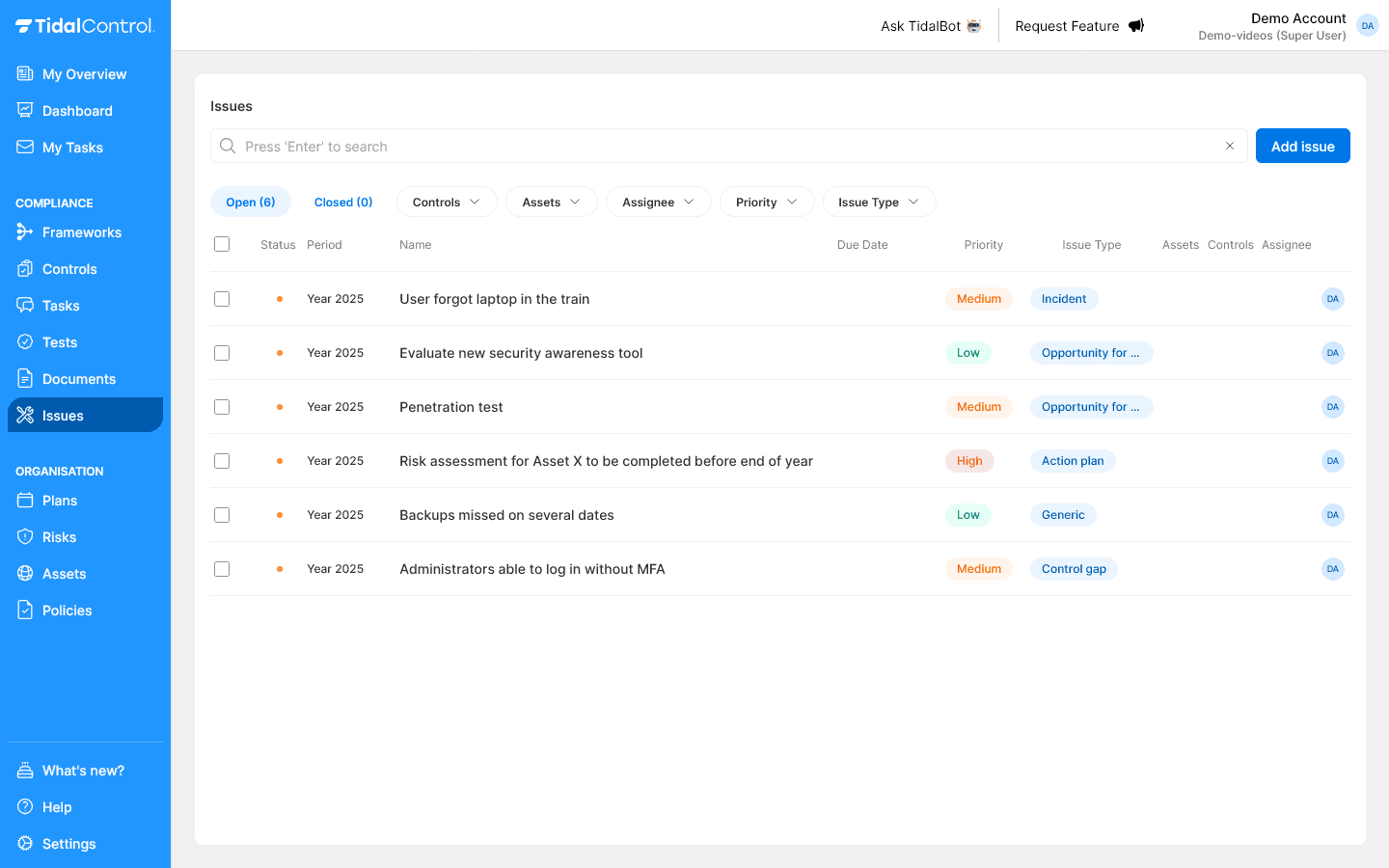Issues
Getting started with Issues
title: Getting started with Issues description: Learn what Issues are in Tidal Control and how to use the Issues page to manage non-conformities and improvement points sidebar_position: 1
What are Issues in Tidal Control?
Issues in Tidal Control are non-conformities, findings and improvement points that can impact your Information Security Management System (ISMS). The system helps you systematically register, assign and resolve these by:
- Recording non-conformities - Document non-conformities and compliance problems
- Registering incidents - Track security incidents and breaches
- Planning improvement actions - Manage opportunities and action plans
- Monitoring progress - Track status and deadlines of solutions
- Facilitating collaboration - Team communication and evidence collection
By registering and monitoring issues in Tidal, you gain insight into compliance status, outstanding problems and the effectiveness of your improvement actions.
Issues can be linked to controls and assets. This creates a complete picture of which problems apply where and how they affect your compliance.
Read more about this in Creating and managing issues
Navigating the Issues page
Opening the Issues page
Go to the Issues section via the main menu. You'll arrive at an overview page where all non-conformities from your organization are displayed.

What you see in the overview
The issues overview shows important information per non-conformity:
- Status - Orange dot for Open issues, green for Closed
- Period - Time period in which issue is registered (e.g. "Year 2025")
- Name - Descriptive title of the non-conformity
- Due Date - Deadline for solution (if set)
- Priority - Urgency level (High, Medium, Low)
- Issue Type - Category of the non-conformity (7 different types)
- Assets - Number of linked business assets
- Controls - Number of linked controls
- Assignee - Assigned person for solution
Understanding status
Open issues (orange dot):
- Unresolved non-conformities
- Actively being worked on or not yet picked up
- Visible in daily work lists
- Counted in compliance calculations
Closed issues (gray):
- Resolved and approved non-conformities
- Visible via "Closed" tab for historical overview
- No longer active in workflows
- Available for audit and reporting
Understanding issue types
Tidal distinguishes 7 different categories of non-conformities:
1. Generic - Default Type
When to use: General problems and administrative matters Example: "Employee screening procedure must be implemented" Characteristics: Broad organizational improvement points
2. Audit finding
When to use: Problems identified during internal or external audits Example: "External auditor identifies missing document for required policy X" Characteristics: Formal findings that threaten compliance
3. Control gap
When to use: Missing or insufficient controls Example: "Access control system doesn't fully restrict admin rights" Characteristics: Identified during GAP analysis, requires new controls
4. Incident
When to use: Security incidents and actual breaches Example: "Phishing attack compromises employee account" Characteristics: Reactive handling of actual events
5. Action plan
When to use: Structured improvement projects and implementations Example: "Employee training program rollout in Q2 for security awareness" Characteristics: Proactive planning of future activities
6. Control deficiency
When to use: Existing controls that don't function effectively Example: "Encryption process has errors leaving data unencrypted" Characteristics: Implemented measures that fail in practice
7. Opportunity for improvement
When to use: Functional processes that can be optimized Example: "Improve onboarding documentation for faster security training" Characteristics: Preventive optimization for better efficiency
Type selection: Choose the most specific type for your issue. This helps with filtering, reporting and assigning to the right experts in your organization.
Interpreting priorities
Priority levels
High - Red:
- Critical security risks
- Compliance threats
- Immediate action required
- Daily monitoring needed
Medium - Orange:
- Important improvement points
- Planned implementation within weeks
- Regular follow-up sufficient
- Standard priority for most issues
Low - Green:
- Nice-to-have improvements
- Long-term planning
- Implementation when time available
- Low impact on compliance
Priority assignment tips
Assign High priority for:
- Audit findings that threaten certification
- Security incidents with ongoing risk
- Compliance deadlines within 30 days
- Issues that disrupt business operations
Medium priority for:
- Planned improvement projects
- Control gaps without direct threat
- Action plans with quarterly deadlines
- Opportunities with measurable benefit
Searching and filtering
Search functionality
Using the search bar:
- Click in the search bar at the top of the overview
- Type issue names or keywords (e.g. "phishing", "backup", "training")
- Press 'Enter' and your search results are displayed
Filter options
Use the filter dropdown menus to find specific issues:
Open vs Closed:
- Open (6) - Active issues requiring attention
- Closed (0) - Handled issues for historical overview
Filter by Controls:
- Show issues linked to specific controls
- Useful for impact analysis of control problems
Filter by Assets:
- Show issues related to specific business assets
- Useful for asset-based problem analysis
Filter by Assignee:
- Show issues assigned to specific people
- Perfect for personal work lists
Filter by Priority:
- High - Critical issues requiring immediate attention
- Medium - Standard priority issues
- Low - Low priority improvement points
Filter by Issue Type:
- Select specific categories (Generic, Audit finding, etc.)
- Combine with other filters for targeted views
It's not possible to create your own filters because attributes are missing for Issues.
Combining multiple filters
You can use different filters simultaneously for very specific results:
- Example: Filter on "Audit finding" + "High" priority + "Open" status to see critical audit findings
- Reset filters: Click away individual filters or refresh the page
Next steps
Now that you know how to find and interpret issues, you can:
- Register new non-conformities you encounter
- Assign issues to the right team members
- Collaborate on solutions via comments
- Monitor progress of outstanding problems
No issues visible? This may mean that no non-conformities have been registered yet in your Tidal environment. Start by adding your first issue via the "Add Issue" button.
- Previous
- Troubleshooting & FAQ